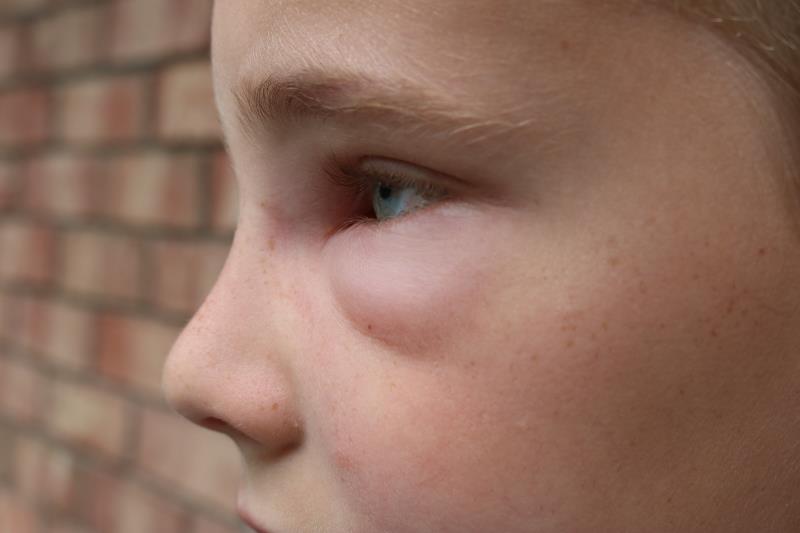
Interim findings from the HELP/HELP OLE* studies presented at AAAAI 2020 have shown that the monoclonal antibody lanadelumab has the potential to reduce hereditary angioedema (HAE) attack rates.
Patients with HAE are often limited in their ability to perform daily tasks, exhibit symptoms of anxiety and depression, and run the risk of asphyxiation from laryngeal attacks, consequently impairing their quality of life. [Allergy Asthma Proc 2013;34:3-6; Clin Rev Allergy Immunol 2016;51:230-239; Acta Derm Venereol 2015;95:706-710]
The currently available prophylactic remedies are limited by venous access issues with intravenous C1 inhibition, higher doses and frequent administrations required for subcutaneous injections, and adverse events from oral androgens. [J Allergy Clin Immunol Pract 2014;2:77-84; N Engl J Med 2017;376:1131-1140; Ann Allergy Asthma Immunol 2015;114:281-288.e7] “[Therefore,] there remains an unmet need in [HAE] management … for an effective, well-tolerated, conveniently administered, long-acting prophylactic therapy,” said the researchers in the initial HELP study. [JAMA 2018;320:2108-2121]
Adolescent cohort
A subanalysis evaluated adolescents (aged 12 to <18 years) from the HELP/HELP OLE cohorts (8/10 percent). Patients from HELP (n=125) were randomized to receive lanadelumab 150 mg Q4W, 300 mg Q4W, 300 mg Q2W, or placebo. HELP OLE patients (n=212) received lanadelumab 300 mg Q2W, including rollover patients from HELP (n=109) and newly enrolled, nonrollover patients (n=103) who could receive existing long-term prophylaxis (LTP) and lanadelumab for ≤3 weeks. [AAAAI 2020, abstract 319]
The 4-week run-in period in HELP saw lower mean monthly attack rates with the monthly doses of lanadelumab (1/0.99 for 150/300 mg) vs the 300-mg Q2W dose and placebo (1.95 and 1.83, respectively). The treatment period mean monthly attack rates were similar across all lanadelumab arms (0/0.3/0.3 for 150 mg Q4W/300 mg Q4W/300 mg Q2W) and were lower than placebo (0.9).
In HELP OLE, mean monthly attack rates during treatment dropped from baseline in both rollover (from 1.65 to 0.24) and nonrollover patients (1.54 to 0.06).
Treatment-emergent adverse events were observed among lanadelumab recipients from HELP/HELP OLE (n=3/11); however, none were serious or severe.
These findings suggest that prophylactic lanadelumab reduced HAE attack rates and was well tolerated among adolescents with HAE, said the researchers.
LTP history
Given the reportedly greater HAE severity tied with LTP history, researchers stratified participants from HELP OLE according to prior LTP use (50 percent with LTP history, 41 percent with no LTP history, and 9 percent receiving other LTPs). [AAAAI 2020, abstract 316]
Compared with the historical monthly rate for the 3 months preceding HELP, mean monthly attack rates were reduced with lanadelumab regardless of history of LTP use (0.3 vs 2.9 [with prior LTP] and 0.2 vs 3.0 [without prior LTP]). These suggest that LTP history did not influence the ability of lanadelumab to prevent HAE attacks, said the researchers.
Baseline attack frequency
In an exploratory analysis evaluating the efficacy of lanadelumab based on baseline HAE attack rates, rollover patients from HELP with ≥1 attack/month at baseline received lanadelumab 300 mg on day 0 then 300 mg Q2W after the first attack. Nonrollover patients with ≥1 attack/3 months received 300 mg Q2W from day 0. [AAAAI 2020, abstract 318]
The fraction of participants who had monthly attack rates of <1, 1 to <2, 2 to <3, and ≥3 at baseline were 12, 35, 14, and 39 percent, respectively. These were reduced by -92, -100, -98, and -97 percent (median), respectively, with lanadelumab use.
“[These suggest that] treatment with lanadelumab produced marked, consistent reductions in monthly HAE attack rates regardless of baseline attack frequency, consistent with the results of the pivotal study,” said the researchers.
Taken together, the findings from these interim analyses support the tolerability and efficacy of lanadelumab in mitigating HAE attack rates, regardless of history of LTP use and baseline frequency of HAE attacks.